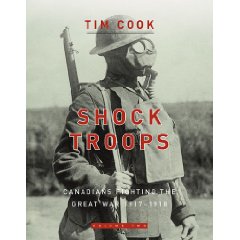Taylor Prize and the creative challenge
I got to thinking, while attending the luncheon for the Charles Taylor Prize for Literary Non-Fiction in Toronto on Monday, about the recent spate of media pieces on the state of writing and book publishing in Canada.
As with most journalism, these pieces focus on the negative — the tightening-up of publisher budgets, the reduction of review space in the newspapers, the closing of independent book stores, and the uncertain future of electronic publishing.
None of this was reflected at the Taylor Prize luncheon. It’s to the credit of my dear friend Noreen Taylor, widow of Charles, that this event has become such red letter day on the literary calendar. It is run with style and grace and on Monday, the three finalists all brought the vigor of youth, creativity and charm to the occasion.
Readers of this blog will know that I predicted Tim Lee would win for his Shock Troops: Canadians Fighting the Great War, 1917-18, the second volume of his history of the Canadian Expeditionary Force in World War I. I’d read the jury — not the books — and made up my mind that a jury composed of a former director of the Canada Council, Shirley Thomson; a serious political journalist, Jeffrey Simpson; and an author and academic of the stature of Warren Cariou would be blown away by Cook’s subject. Now I’ll be certain to read it.

I’m sure the other books, Sugar: A Bittersweet History by Elizabeth Abbott and Angel of Vengeance: The ‘Girl Assassin,’ the Governor of St. Petersburg and Russia’s Revolutionary World by Ana Siljak also demonstrate “a superb command of the English language, an elegance of style and a subtlety of thought and perception” as required of all Taylor Prize winners.
The fact that the Taylor Prize for 2008 drew 135 entries from 43 publishers tells me publishing isn’t in quite as bad shape as you’d be led to believe by some of the stuff we’ve been seeing in the media. James Adams, the able publishing reporter for The Globe and Mail, set off a small firestorm in writer circles with his article, Publish and your book will probably perish, in last Saturday’s paper. Judging from comments posted to the Writer’s Union Listserv, I’d say not all writers share such pessimism.
Toronto Life has an equally dismal piece, The Blockbuster Imperative, dealing with the work of novelist Anne Michaels. Her new book The Winter Vault, arrives in a ” savage environment,” writes Don Gilmor:
The Winter Vault comes at a gloomy time; its title may be an apt metaphor for the publishing industry at the moment. And while the book has its share of bleak images, like Fugitive Pieces, it is ultimately redemptive. Perhaps that will be enough.
If creativity is the be-all and end-all, why are the creators so badly paid? I’ll take a run at this issue in another blog.
-
February 10, 2009 at 1:27 pmWhat’s Buzzing? » Blog Archive » The Twilight Zone: Season 3 (the Definitive Edition) | Markmutti.Com
-
February 11, 2009 at 4:01 amany advice on writing a book? :Write Better!